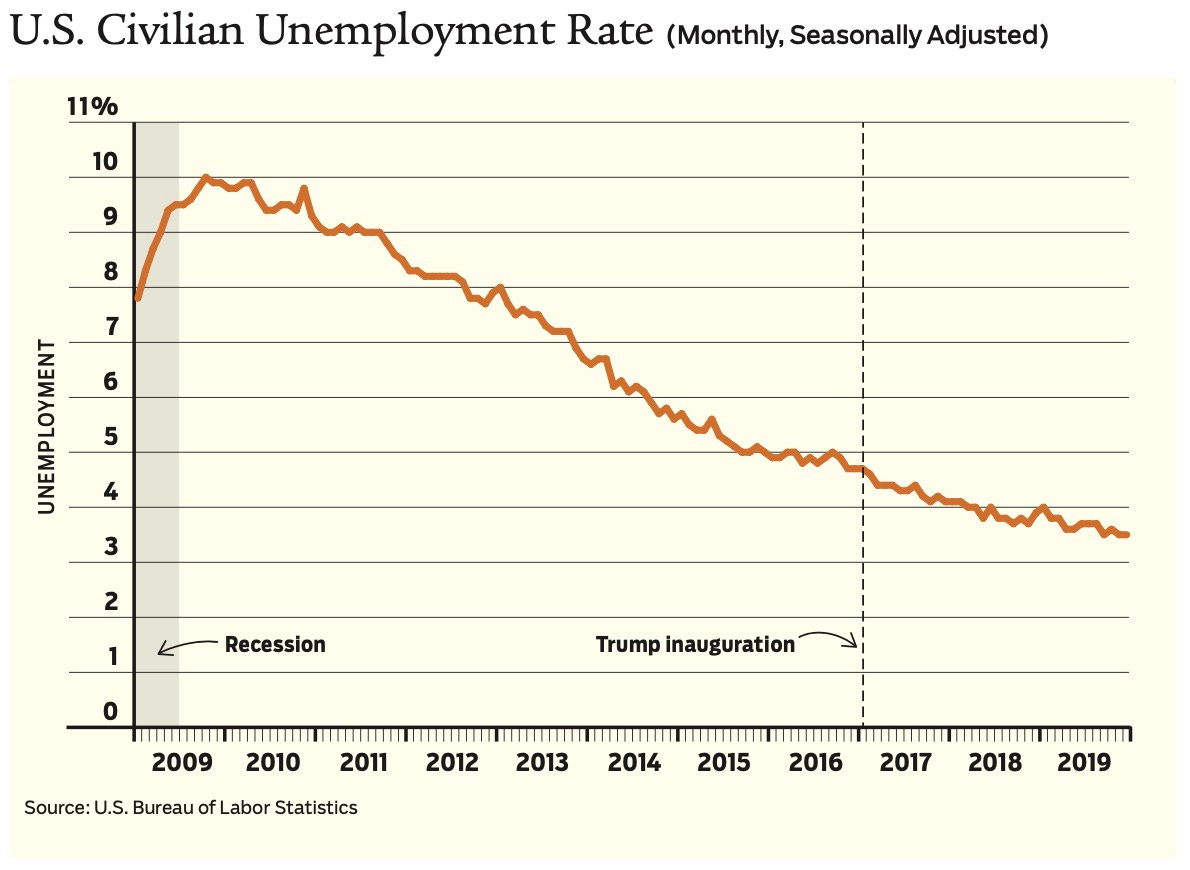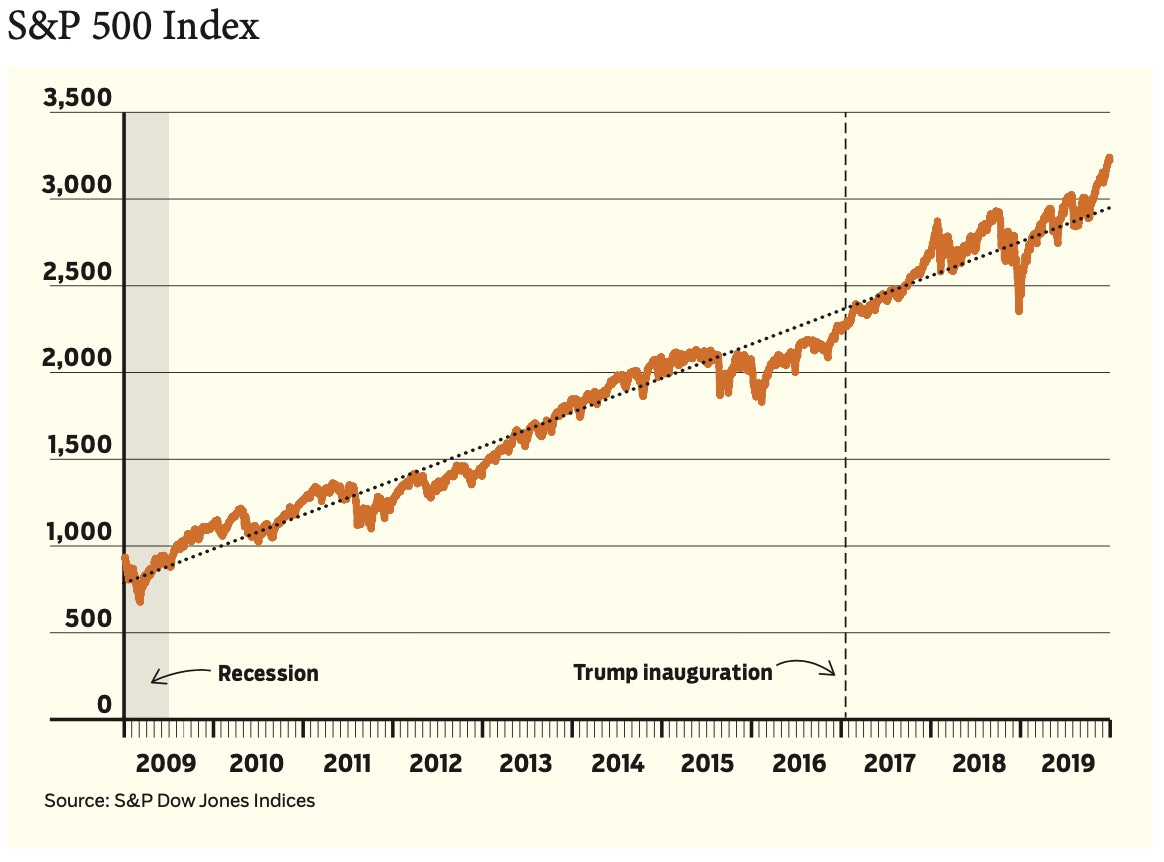

Before COVID-19, President Trump intended to make his stewardship of the American economy the centerpiece of his reelection campaign. Even with the pandemic, he will likely do so, claiming that he made the economy great before and will do so again.
But did Trump boost the U.S. economy before COVID-19?
The answer to this question isn’t as obvious as the president’s boosters would have you believe.
At the start of 2020 unemployment was nearing historically low levels, gross domestic product was at an all-time high, and equities markets were surging. But does Trump deserve credit for any of that?
In the latest issue of the Cato Institute’s policy journal Regulation, economist Pierre Lemieux tries to answer that question by analyzing U.S. economic data under Trump and his predecessor, Barack Obama. Here are some of his findings.
Consider the unemployment rate over the last decade.

As noted, it was nearing historic lows in 2019, a remarkable change from the 10 percent it reached in October 2009, four months after the end of the Great Recession. From that point in October 2009, the unemployment rate declined steadily, first under the final seven years of the Obama administration—falling to 4.7 percent in December 2016—and then falling to 3.5 percent under Trump in late 2019.
This decline continued under Trump, but did not accelerate after Trump became president in January 2017. If anything, the rate of improvement slowed down. Now that’s to be expected for the simple reason that there wasn’t much further for it to fall as it neared frictional levels.
This was all great news for American workers, but it doesn’t suggest that President Trump performed any better on the economy than his predecessor.
Equity prices show a similar pattern. The stock market reached new highs in 2019:

Those highs came after a decade of fairly steady growth under both Trump and Obama. But notice, again: There’s no obvious change in the trend following Trump’s 2017 inauguration. The average daily increase in the index was 0.0500 percent under Obama and 0.0502 percent under Trump (until 2020). Once more, the economy seemed to be doing the same under Trump as it did under his predecessor.
The GDP offers somewhat better news for Trump. When measured by real (inflation-adjusted) GDP per capita, the nation did better under Trump (again, until 2020). Under Obama, the average annual growth in this measure (starting in 2010) was 1.4 percent. Under Trump it averaged 2.0 percent. But growth slowed slightly in 2019, falling to 1.8 percent.
And moreover, 2 percent is no great shakes. If anything, these data show a slow recovery from the Great Recession under both presidents.
Wage data presents a similar picture. According to the 2020 Annual Report of the President’s Council of Economic Advisers, real wages of workers at the bottom of the income distribution improved during the Trump presidency:
The real wages of private sector production and nonsupervisory workers increased by 1.9 percent during the year ended in November 2019.
You can see that here:

But notice that the significant increases only started in mid-2018, and all gains in 2019 were cancelled out by the last two months of the year. Overall, the average annualized monthly rate of increase under Trump was 1.2 percent (before 2020), only slightly better than Obama’s 1.0 percent.
What about the federal government’s fiscal health, which could be an important factor in how the United States weathers the economic shock from COVID-19?
The country was burdened with heavy debt at the end of the Obama administration, as then-candidate Trump stressed to Washington Post reporters Bob Woodward and Robert Costa in the spring of 2016.
“We’ve got to get rid of the $19 trillion in debt,” he said, referring to the gross federal debt (which actually was $18.1 trillion at the end of 2015). “How long would that take?” the interviewers asked. “I would say over a period of eight years,” he responded.
Over the first three years of his administration, Trump went in the opposite direction, increasing the annual budget deficit from $585 billion (in Obama’s last year) to $984 billion in the fourth quarter of fiscal year 2019.
This increase was due mainly to higher government spending. By December 31, 2019, the gross federal debt had increased 14 percent since 2016 and reached $22.7 trillion—and all of that before COVID-19 hit.
President Trump’s attitude on debt and deficit seems to have changed somewhat since his interview with Woodward and Costa. At a January 17, 2020 Republican fundraiser, Trump declared “Who the hell cares about the budget? We’re going to have a country.”
What do these and other data from Lemieux’s article tell us about President Trump’s economic policies?
First, the data show that the economy more-or-less followed the same course in the first three years of Trump’s administration that it did over the last seven years of the Obama administration.
Second, Trump’s administration rang up trillions of dollars in new government debt even before it began spending to fight the effects of COVID-19.
That’s his actual record. He should own it.









